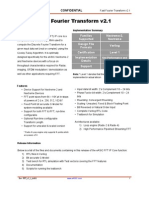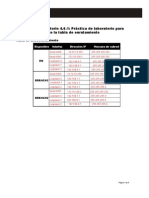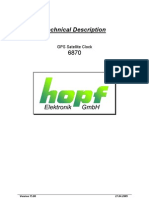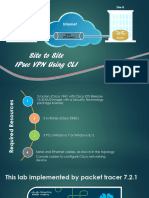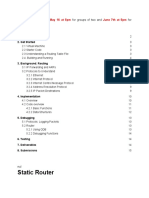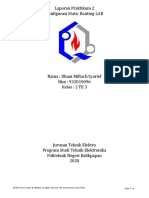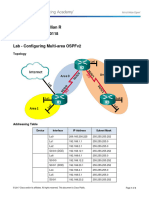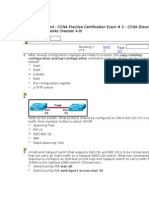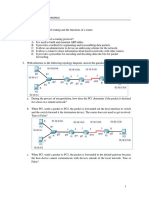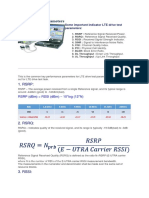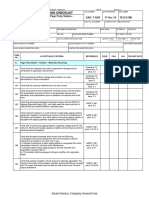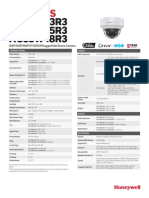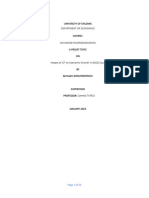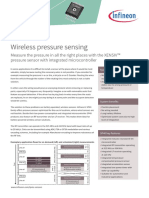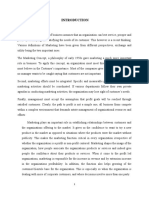E6870 Programming Manual 0400
E6870 Programming Manual 0400
Uploaded by
MacakafkaCopyright:
Available Formats
E6870 Programming Manual 0400
E6870 Programming Manual 0400
Uploaded by
MacakafkaOriginal Title
Copyright
Available Formats
Share this document
Did you find this document useful?
Is this content inappropriate?
Copyright:
Available Formats
E6870 Programming Manual 0400
E6870 Programming Manual 0400
Uploaded by
MacakafkaCopyright:
Available Formats
Technical Description
Programming Manual
6870
version 04.00 07.03.2000
Company Info KRSI Elektronik
KRSI
KRSIBBElektronik
Nottebohmstr. 41 58511 Lüdenscheid
Postfach 1847 58468 Lüdenscheid
Tel.: ++49 (0)2351 / 938686
Fax: ++49 (0)2351 / 459590
Internet: http://www.hopf-time.com
e-mail: info@hopf-time.com
version 04.00 page 2
Table of Contents KRSI Elektronik
INHALT Seite
1 Service Functions of the Serial Interface 5
2 Time Functions 6
2.1 The Statusbyte and Structure of the Data String in the TIM Command 6
2.2 Setting the Time 7
2.3 Requesting the Time 8
2.4 Setting the Point of Changeover 8
2.5 Requesting the Points of Changeover 9
2.6 Difference Time UTC - Local 9
3 Initialising Functions of the Receiver 10
3.1 Setting the Position Data 10
3.2 Setting Decoding Mode Position Fixed 3D and GPS-Reception Quality 10
3.3 Starting Reset of the Clock System 11
4 Configuration of the Serial Interface 12
4.1 Parameterbyte of the serial Interface 12
4.2 Modebyte 1 of the serial interface 13
4.3 Modebyte 2 of the Serial Interfaces 15
5 Optical Coupler Configuration 16
5.1 Structure of the Statusbyte 16
5.2 Pulses 17
5.2.1 Cyclic Output Mode 4 17
5.2.2 Single Pulse Mode 5 17
6 DCF77 Simulation and Sync-Bit Settings 17
7 Remote Software for a Personal Computer 18
8 Pin Assignment of the Serial Interfaces 18
version 04.00 page 3
Table of contents - continued KRSI Elektronik
version 04.00 page 4
GPS-satellite clock 6870 - programming manual KRSI Elektronik
1 Service Functions of the Serial Interface
Remote functions are required for the installation of the clock from a remote computer. To do so
various data strings for the setting of time, date, points of changeover (daylight saving / standard
time) position data, difference time local-UTC and decoding of the GPS reception quality are
transmitted. It is also possible to parameter the serial interface. The program GPS_6870
(included in the delivery of the clock) uses the functions described below.
The remote functions are implemented in interface 1 only.
When the remote function is activated the standard data traffic on the interface is interrupted for
about 15 seconds.
The control characters STX and ETX cannot be excluded from the transmitted remote string,
they are always part of the remote data strings.
The start of a communication between clock and computer is always activated by the computer.
The respective data string is structured as follows:
STX (command) [status] [data] CR LF ETX
The STX (Hex 02) and the CR (Hex 0D), LF (Hex 0A) and ETX (Hex 03) at the end of the string
form the core of the transmission.
The command field contains four ASCII-characters which indicate the function.
The following commands are possible:
TIM: for time and date
COS: for setting points of changeover
DIF: for difference time local-UTC
POS: for position data
SAT: for reception quality
RES: for reset of the clock system
IMP: for the configuration of the optical coupler outputs
DCF: for the DCF77 simulation and the sync.-bit
PAR: for parameterbyte of interface 1
PA1: for parameterbyte of interface 2
MOD: for modebyte 1 of interface 1
MO1: for modebyte 2 of interface 1
MO2: for modebyte 1 of interface 2
MO3: for modebyte 2 of interface 2
SYB: for the systembyte
VER: for version information
The fields status and data are optional and depend on the command or on the requested func-
tion.
The TIM command is always transmitted with a status. The status indicates whether a time in-
formation or a point of changeover is part of the data string. The other commands are transmit-
ted without status.
version 04.00 page 5
GPS-satellite clock 6870 - programming manual KRSI Elektronik
2 Time Functions
2.1 The Statusbyte and Structure of the Data String in the TIM Command
The statusbyte consists of two ASCII nibbles. The value range of each nibble can be Hex 30-39
or Hex 41-46 (00-FF). Once the two characters are received they are converted into binary val-
ues.
example :
The two ASCII characters "4" and "2" (Hex 34 and 32) are received and the ASCII conversion
results in the following byte:
Bit 7 Bit 6 Bit 5 Bit 4 Bit 3 Bit 2 Bit 1 Bit 0
0 1 0 0 0 0 1 0
Depending on whether the clock receives or transmits a TIM command the statusbyte has the
following meaning:
Bits in the transmitted statusbyte (from the clock system):
Bit 7 = 1, Bit 6 = 1 clock is radio synchronous with crystal control
Bit 7 = 1, Bit 6 = 0 clock is radio synchronous without crystal control
Bit 7 = 0, Bit 6 = 1 clock is in crystal operation (valid time)it)
Bit 7 = 0, Bit 6 = 0 clock has no valid time
Bit 5 = 1 announcement of a leap second on the next hour change
Bit 4 = 1 standard time/local time
Bit 3 = 1 daylight saving time (only when operating with changeover)
Bit 4 = 0, Bit 3 = 0 UTC-time (Universal Time Co-ordinated)
Bit 2 = 1 daylight saving / standard time - standard time / daylight saving -
changeover on the next hour change
Bit 0 = 1 only in case of changeover: changeover is done
Bit 0 = 0 points of changeover still active
Meaning of the bits in the received statusbyte:
Bit 7 no meaning
Bit 6 = 1 must always be set
Bit 5 = 1 clock is to insert a leap second on the next hour change (please
note: for diagnostic purposes only)
Bit 4 = 0/1 UTC / Local Time
Bit 3 = 0 no meaning
Bit 2 no meaning
Bit 1 no meaning
Bit 0 no meaning
version 04.00 page 6
GPS-satellite clock 6870 - programming manual KRSI Elektronik
During transmission the data field in the TIM data string contains the current settings of the
clock. During reception the latest times are entered. If the data field is missing during reception
the received status is scanned for requested clock data and the transmission of respective data
are released by the clock at the next possible point of time.
The data are transformed and received as ASCII values in BCD. Received data are checked for
plausibility by the clock. The clock recognises invalid data like e.g. day=32 in the data string and
ignores the whole string. The day of the week nibble must always be stated 1 = Monday ... 7 =
Sunday.
Structure of the data field in the string:
character no.: meaning value ( value range)
1 comma $2C
2 hour tens $30-32
3 hour unit $30-39
4 comma $2C
5 minute tens $30-35
6 minute unit $30-39
7 comma $2C
8 second tens $30-35
9 second unit $30-39
10 comma $2C
11 day tens $30-33
12 day unit $30-39
13 comma $2C
14 month tens $30-31
15 month unit $30-39
16 comma $2C
17 year tens $30-39
18 year unit $30-39
19 comma $2C
20 day of the week $31-37
2.2 Setting the Time
Statusbyte (Hex) meaning
48 setting local time
Example data string setting local time 12:34:56 clock, Sunday 07.08.99
STX TIM: 48,12,34,56,07,08,99,7 CR LF ETX
After the data are taken over the clock answers with the new time data string:
STX TIM: 48,12,34,56,07,08,99,7 CR LF ETX
version 04.00 page 7
GPS-satellite clock 6870 - programming manual KRSI Elektronik
2.3 Requesting the Time
Statusbyte (Hex) meaning
40 requesting UTC (world time)
48 requesting local time
Example data string for requesting the time:
STX TIM: 40 CR LF ETX
At the next possible point of time the clock answers with the current world time:
example: STX TIM: 40,10,34,56,07,08,99,7 CR LF ETX
It is 10:34:56 h, Sunday 07.08.99 world time
2.4 Setting the Point of Changeover
Here the points of changeover are entered when the time is changed during the course of the
year to daylight saving or standard time The transmission contains hour and month separately
for daylight saving and standard time. The changeover always takes place on the first or the
last Sunday of the stated month and on the stated hour. If bit 0 in the status is set the changeo-
ver is done on the first Sunday of the month (status 4B and 53). If bit 0 =0 the changeover is
done on the last Sunday of the month (status 4A and 52).
Hinweis : Naughts are entered for all the digits for countries which do not have or
want a changeover.
Structure of Data String:
character no. value ( value range) meaning
1 4A or 4B status summer point of changeover
2 00-23 hour when time is changed to daylight sav-
ing time
3 01-12 month when time is changed to daylight
saving time
4 52or 53 status point of changeover
5 00-23 hour when time is changed to standard time
6 01-12 month when time is changed to standard
time
example setting points of changeover:
STX COS: 4A,02,03,52,03,10 CR LF ETX
As soon as the clock has received the data string it answers with the new points of changeover:
STX COS: 4A,02,03,52,03,10 CR LF ETX
The changeover to daylight saving time always takes place at 02:00h on the last Sunday in
March.The changeover to standard time is at 03:00 on the last Sunday in October.
version 04.00 page 8
GPS-satellite clock 6870 - programming manual KRSI Elektronik
2.5 Requesting the Points of Changeover
Requesting the example data string for the winter points of changeover
STX COS: CR LF ETX
As soon as possible the clock answers with the current points of changeover
example: STX COS:4A,02,03,52,03,10 CR LF ETX
The changeover to daylight saving time is at 02:00 on the last Sunday in March. The changeover
to standard time is at 03:00 on the last Sunday in October.
2.6 Difference Time UTC - Local
Use the DIF command to set or request the difference between local time and UTC. The data
field for this command looks as follows:
meaning value range (Hex)
direction +/- 2B, 2D
hour tens 30-32
hour unit 30-39
comma 2C
minute tens 30-35
minute unit 30-39
The difference time must not exceed ± 12 hours.
Example data string setting the difference between local time and UTC to - 1 hour
STX DIF: -01,00 CR LF ETX
The current difference is requested by the following data string:
STX DIF: CR LF ETX
Once it has received the data string it answers with the new difference time:
STX DIF: +02,00 CR LF ETX
version 04.00 page 9
GPS-satellite clock 6870 - programming manual KRSI Elektronik
3 Initialising Functions of the Receiver
3.1 Setting the Position Data
The position data for the respective location of the clock system are set or requested by this
data string.
Structure of the data string:
character no. meaning ASCII value ( value range)
1 longitude West/East W, E $57, 45
2 colon : $3A
3 degree hundreds 0,1 $30, 31
4 degree tens 0-8 $30-37
5 degree unit 0-9 $30-39
6 comma , $2C
7 minute tens 0-5 $30-35
8 minute unit 0-9 $30-39
9 comma , $2C
10 minute a hundredth 0-9 $30-39
11 minute a thousandth 0-9 $30-39
12 comma , $2C
13 latitude North/South N, S $4E,53
14 colon : $3A
15 degree tens 0-8 $30-38
16 degree unit 0-9 $30-39
17 comma , $2C
18 minute tens 0-5 $30-35
19 minute unit 0-9 $30-39
20 comma , $2C
21 minute hundredth 0-9 $30-39
22 minute thousandth 0-9 $30-39
Example data string for setting the position data:
STX POS: E:007,33,34,N:53,12,21 CR LF ETX
3.2 Setting Decoding Mode Position Fixed 3D and GPS-Reception Quality
The following data string is used to set the decoding mode position fixed or 3D decoding:
STX SAT: 0 CR LF ETX setting decoding to Position Fixed
STX SAT: 1 CR LF ETX setting decoding to 3D
The clock answers with the data strings described below.
version 04.00 page 10
GPS-satellite clock 6870 - programming manual KRSI Elektronik
The data string
STX SAT: CR LF ETX
asks for the current satellite data without change of the decoding mode.
The clock answers with the number of traced satellites and a relative value for the signal/noise
ratio. This value may range between 0..255, values larger than 50 representing a good recep-
tion.
The data field is structured as follows:
character no. meaning ASCII value ( value range)
1 ident.of satellite track T 53
2 colon : 3A
3 number of traced sat . 0-9 30-39
4 comma , 2C
5 Ident. of sat. S 53
6 colon : 3A
7 tens sat.-no. 0-9 30-39
8 unit sat.-no. 0-9 30-39
9 slash / 2F
10 hundreds SN-ratio 0-9 30-32
11 tens SN-ratio 0-9 30-39
12 unit SN-ratio 0-9 30-39
13 comma , 2C
:
:
55 identifier mode M
56 colon :
57 mode 0, 1 30, 31
Position 5 to 13 is repeated for 6 satellites!
Position 57 indicates the decoding mode.
0 = decoding with Position Fixed
1 = decoding with 3D
Example of a transmitted answer with satellite data:
STX SAT: 08,S:07/143,S:12/145,S:23/034,S:14/145,S:03/123,S:19/047, M:1 CR LF ETX
3.3 Starting Reset of the Clock System
The following data string is used to start a reset (masterreset):
STX RES: CR LF ETX
The clock uses with the following data string,
STX RES: CR LF ETX
to indicate that the command is carried out.
version 04.00 page 11
GPS-satellite clock 6870 - programming manual KRSI Elektronik
4 Configuration of the Serial Interface
4.1 Parameterbyte of the serial Interface
For setting the baud rate etc. please refer to pt.1.2 of this manual. The serial interfaces are
parametered by the following string:
character no. meaning ASCII value ( value range)
1 baudrate tenthousands 0-1 30-31
2 baudrate thousands 0-9 30-39
3 baudrate hundreds 0-9 30-39
4 baudrate tens 0 30
5 baudrate unit 0 30
6 comma , 2c
7 paritybit N,E,O 4e,45,4f
8 comma , 2c
9 data bit 7,8 37,38
10 comma , 2c
11 stop bit 1,2 30,31
Possible baudrates including leading naughts are:
• 19200
• 09600
• 04800
• 02400
• 01200
• 00600
• 00300
• 00150
Example data string of setting the parameter :
STX PAR:09600,N,8,1 CR LF ETX
This string sets the serial interface 1 to the following setting:
9600 baud, no parity, 8 data bits, 1 stop bit
STX PA1:09600,N,8,1 CR LF ETX
this string sets the serial interface 2 to the following setting:
9600 baud, no parity, 8 data bits, 1 stop bit
version 04.00 page 12
GPS-satellite clock 6870 - programming manual KRSI Elektronik
4.2 Modebyte 1 of the serial interface
Modebyte 1 sets operating modes. Every bit represents a switch which is either on = 1 or off = 0.
The meaning of the bit position is as follows:
Bit 8 output of time information
off UTC time
on local time
Bit 7 second advance
off with second advance
on without second advance
Bit 6 transmission with
control characters
off with control characters
on without control characters
Bit 5 ETX on the second change
only if 'with control characters' was selected
off with ETX on the second change
on without ETX on the second change
Bit 4 control characters CR/LF
off LF/CR
on CR/LF
Bit 3 free
off
on
Bit 2 Bit 1 point of transmission
off off transmission every second
off on transmission on the minute change
on off transmission on the hour change
on on transmission on request only
version 04.00 page 13
GPS-satellite clock 6870 - programming manual KRSI Elektronik
character no. meaning ASCII value ( value range)
1 Bit 8 0-1 30-31
2 comma , 2c
3 Bit 7 0-1 30-31
4 comma , 2c
5 Bit 6 0-1 30-31
6 comma , 2c
7 Bit 5 0-1 30-31
8 comma , 2c
9 Bit 4 0-1 30-31
10 comma , 2c
11 Bit 3 0-1 30-31
12 comma , 2c
13 Bit 2 0-1 30-31
14 comma , 2c
15 Bit 1 0-1 30-31
Example data string modebyte 1 for setting serial interface 1:
STX MOD:1,1,0,1,1,0,0,0,CR LF ETX
Example data string modebyte 1 for setting serial interface 2:
STX MO2:1,1,0,1,1,0,0,0,CR LF ETX
This string sets the following transmission mode:
• transmission every second
• transmission without control characters
• transmission without ETX as on-time marker
• transmission sequence of control characters CR/LF
• transmission without second advance
• output local time
version 04.00 page 14
GPS-satellite clock 6870 - programming manual KRSI Elektronik
4.3 Modebyte 2 of the Serial Interfaces
Modebyte 2 sets the transmission string; every bit represents a switch, which knows either the
status on=1 or off=0. Meaning of the individual bit positions:
Bit 3 Bit 2 Bit 1 Bit 0 String
off off off off standard 6021 compatible date and time
off off off on standard 6021 compatible time only
off off on off DCF77 slave
off off on on Siemens Sinec H1
off on off off Siemens MADAM S
off on off on IBM Sysplex Timer
off on on off standard 6021 compatible with year 2000
off on on on T-string
on off off off ABB_T_string
on off off on NGTS-string
on off on off master/slave-string
on off on on SPT-string
on on off off at present standard 6021 compatible date and time
on on off on at present standard 6021 compatible date and time
on on on off at present standard 6021 compatible date and time
on on on on at present standard 6021 compatible date and time
character no. meaning ASCII value ( value range)
1 Bit 7 0-1 30-31
2 comma , 2c
3 Bit 6 0-1 30-31
4 comma , 2c
5 Bit 5 0-1 30-31
6 comma , 2c
7 Bit 4 0-1 30-31
8 comma , 2c
9 Bit 3 0-1 30-31
10 comma , 2c
11 Bit 2 0-1 30-31
12 comma , 2c
13 Bit 1 0-1 30-31
14 Bit 0 0-1 30-31
version 04.00 page 15
GPS-satellite clock 6870 - programming manual KRSI Elektronik
example string for setting modebyte 2 for serial interface 1:
STX MO1:0,0,0,0,0,0,0,0,CR LF ETX
example string for setting modebyte 2 for serial interface 2:
STX MO3:0,0,0,0,0,0,0,0,CR LF ETX
This string sets the following transmission mode:
Transmission standard string 6021 compatible
5 Optical Coupler Configuration
The IMP-command is used to configure the optical couplers. The data string which is to be
transmitted consists of the identifier nibble of the optical coupler, the statusbyte and 3 further
bytes to set the pulse.
Structure of data string: IMP:o,st,ho,mi,se,im
command description value range
IMP: pulse command 4 ASCII Bytes
o corresponding optical coupler 1 Byte hex 31-33
st statusbyte 2 Bytes (see status)
ho value for the hour 2 Bytes ASCII 00-23
mi value for the minute 2 Bytes ASCII 00-59
se value for the second 2 Byte ASCII 00-59
im value for the pulse length 2 Byte ASCII 00-FF
5.1 Structure of the Statusbyte
The statusbyte sets the output mode of the optical couplers. At present the statusbyte uses the
lower 4 bits (0-3) only. The higher bits must always be set to 0.
Bit 7-4 Bit 3 Bit 2 Bit 1 Bit 0 meaning
0 x x 0 0 mode 1: output DCF77-simulation
0 x x 0 1 mode 2: output status radio/crystal operation
0 x x 1 0 mode 3: output system o.k.
0 x 0 1 1 mode 4: cyclic output
0 x 1 1 1 mode 5: single pulse
0 0 x x x not inverted output
0 1 x x x inverted output (only mode 1, 4 and 5)
version 04.00 page 16
GPS-satellite clock 6870 - programming manual KRSI Elektronik
5.2 Pulses
Depending on the set mode in the statusbyte the 3 bytes for the pulse times and the 3 bytes for
the date are decoded.
5.2.1 Cyclic Output Mode 4
In this setting only one value in one of the 3 time bytes (ho, mi, se) can be set with one of the
following values. The bytes dy, mo, and yr must be set to 00:
ho = 0, 1, 2, 3, 4, 6, 8, 12, 24
mi = 0, 1, 2, 3, 4, 5, 6, 10, 12, 15, 20, 30
se = 0, 1, 2, 3, 4, 5, 6, 10, 12, 15, 20, 30
Also the pulse length in the last byte must be set in steps of 10msec.
The example data string: IMP:2,0B,00,15,00,64,00,00,00
sets at the optical coupler 2 an inverted pulse of 1 second and a cycle of 15 minutes.
5.2.2 Single Pulse Mode 5
This operating mode requires a logical value in the three time bytes and a the length must be set
in steps of 10 msec in the pulse byte. If the bytes dy, mo, yr are set to naught the pulse is sent
once every day.
The example data string: IMP:1,07,23,59,59,64,00,00,00
sets at the optical coupler 1 a daily pulse of 1 second at 23:59:59 .
If the bytes dy, mo, yr are filled with a date the pulse is sent on those days only. The date is
checked for plausibility first.
The example data string: IMP:1,07,23,59,59,64,29,02,00
sets at the optical coupler 1 a pulse of 1 second on 29. Feb. 2000 at 23:59:59 .
6 DCF77 Simulation and Sync-Bit Settings
This data string configures the DCF77-simulation and the radio bit.
structure of string: CF:mi,hi,lo,sy
command description value range
DCF: DCF77 Sim and radio bit 4 ASCII Bytes
mi entered minutes of DCF77 switch off 2 Byte ASCII 00-FF
hi pulse length DCF77 Highbit 2 Bytes ASCII
lo pulse length DCF77 Lowbit 2 Bytes ASCII
sy delay in minutes of sync.bit switch off 2 Bytes ASCII 00-FF
The length of the DCF77 pulse entered must not exceed the following span:
DCF77 Highpulse: 140-230
DCF77 Lowpulse: 50-130
version 04.00 page 17
GPS-satellite clock 6870 - programming manual KRSI Elektronik
The example data string:
DCF:3C,C8,64,3F
sets the switch off of the DCF77-simulation (optical coupler and antenna output) in case of a
disturbed reception to 60 minutes, the pulse length highbit to 200msec and lowbit to 100msec.
The syc.bit is also switched off after 60 minutes.
7 Remote Software for a Personal Computer
There is a software available under MS Windows 3.x or higher for the remote control of the clock
system.
This programme is used to carry out all the above described functions from a PC or laptop.To be
able to do so the computer must be connected to the clock system via a free serial interface.
The software includes the following functions:
• entry of clock data (time, date)
• entry of position data
• checking for plausibility of the entered data
• creating and transmission of the above data string to the clock system
• monitoring the process by decoding and display of the answer data string
• setting of the optical couplers
• storing of all settings in a set-up file
• print-out of all settings
• monitoring of the previously set output data strings
8 Pin Assignment of the Serial Interfaces
Interface Signal at the 9-pole SUB-D connector
Pin no.: name of signal
1
2 RxD Receive Data
3 TxD Transmit Data
4
5 GND Ground
6
7
8
9
The KRSI
KRSIBBcompany withholds the right to alterations of hard- and software at any
time. The names used in this documentation like MSDos, IBM, Siemens, Windows
etc. are registered trademarks of the respective companies.
version 04.00 page 18
You might also like
- 2.3.2.7 Lab - Configuring Basic PPP With AuthenticationDocument17 pages2.3.2.7 Lab - Configuring Basic PPP With AuthenticationTony Blanco100% (1)
- Biolis 50i Bi-Directional ASTM (Ver.1.01)Document51 pagesBiolis 50i Bi-Directional ASTM (Ver.1.01)Christian Stwar Velásquez Acosta100% (2)
- E2 Lab 2 8 2Document16 pagesE2 Lab 2 8 2josefalarkaNo ratings yet
- Luminato Configuration GuidelinesDocument68 pagesLuminato Configuration GuidelinesEmin HukicNo ratings yet
- Technical Description: GPS Satellite ClockDocument57 pagesTechnical Description: GPS Satellite ClockProcurement PardisanNo ratings yet
- PROFIBUS-PA Function Block and Parameter Manual (15.1.14)Document31 pagesPROFIBUS-PA Function Block and Parameter Manual (15.1.14)Amine SahnounNo ratings yet
- OSRD Protocol For Bosch PTZ Cameras Receiver - Drivers, G1, G2, G3, VEZ, and VG4 Series AutoDomes. Instruction BookDocument42 pagesOSRD Protocol For Bosch PTZ Cameras Receiver - Drivers, G1, G2, G3, VEZ, and VG4 Series AutoDomes. Instruction Bookpilar52668No ratings yet
- Easic Ipds 08 FFT v2 1 DatasheetDocument64 pagesEasic Ipds 08 FFT v2 1 DatasheetcnbattsonNo ratings yet
- Network Configuration & Management Lab Tutorial - 1 of Lesson – 7Document26 pagesNetwork Configuration & Management Lab Tutorial - 1 of Lesson – 7alfredatika05No ratings yet
- SimCoder User ManualDocument348 pagesSimCoder User ManualHeitor B. S. BezerraNo ratings yet
- Secondary Micro User GuideDocument52 pagesSecondary Micro User GuideschourasiyavecvNo ratings yet
- Lab-03 Dynamic RoutingDocument14 pagesLab-03 Dynamic Routingshefat2002No ratings yet
- Guia - Interfaceamento - LABMAX240Document60 pagesGuia - Interfaceamento - LABMAX240Leandro DoninNo ratings yet
- Speedometer: Embedded Hardware Design ProjectDocument46 pagesSpeedometer: Embedded Hardware Design ProjectYhugan RpcNo ratings yet
- Network Routing Protocols - A BriefDocument72 pagesNetwork Routing Protocols - A BriefAswath Farook100% (1)
- Activity-Static RoutingDocument2 pagesActivity-Static Routingdhanmeetkaur95No ratings yet
- Lab 4 6 1Document5 pagesLab 4 6 1pisciano009No ratings yet
- Cisco Network Time Protocol (NTP)Document15 pagesCisco Network Time Protocol (NTP)rahul nikamNo ratings yet
- E6870 1500Document72 pagesE6870 1500Flavius DumitrescuNo ratings yet
- TCPIP Protocol Suite (4th Edition)Document24 pagesTCPIP Protocol Suite (4th Edition)Sumit ShakyaNo ratings yet
- Cisco Packet Tracer - Idrees Abbas - 988-2024 - DCCN LabDocument28 pagesCisco Packet Tracer - Idrees Abbas - 988-2024 - DCCN Labidrees.abbas34563No ratings yet
- 7.3.2.7 Lab - Testing Network Connectivity With Ping and TracerouteDocument16 pages7.3.2.7 Lab - Testing Network Connectivity With Ping and TracerouteRaja Dang Jalernpan100% (6)
- Original Commodore Business Machines Plus 4 Docs, The, (2003) (Lidovski, V)Document40 pagesOriginal Commodore Business Machines Plus 4 Docs, The, (2003) (Lidovski, V)BASILEIOS KATHOLOSNo ratings yet
- DCN Practical 5Document14 pagesDCN Practical 5raj ponkiyaNo ratings yet
- IPsec Site To Site LABDocument50 pagesIPsec Site To Site LABsmehranm.t1382No ratings yet
- CCNA 2 Practice Final ExamDocument19 pagesCCNA 2 Practice Final ExamDebbie M. LazoNo ratings yet
- Assignment 2Document15 pagesAssignment 2ZaskelNo ratings yet
- Cisco ITP Exercise and Answer v00.02Document23 pagesCisco ITP Exercise and Answer v00.02bayoubgoor100% (1)
- E2 Lab 2 8 2Document7 pagesE2 Lab 2 8 2Ninja NuggetNo ratings yet
- 1 - Configuration Demo I PDFDocument8 pages1 - Configuration Demo I PDFPriyanka BeheraNo ratings yet
- Midterm Lab 2-Testing-Network-Connectivity-with-Ping-and-Traceroute (20240505124030)Document15 pagesMidterm Lab 2-Testing-Network-Connectivity-with-Ping-and-Traceroute (20240505124030)getalon57No ratings yet
- Configuring Frame-Mode MPLS On IOSDocument71 pagesConfiguring Frame-Mode MPLS On IOSRafael A Couto CabralNo ratings yet
- EWAN Lab 2 5 2 AnswerDocument13 pagesEWAN Lab 2 5 2 AnswerLekan MulanaNo ratings yet
- Transport Layer: by Eng. Ali Al-Obal 2017Document13 pagesTransport Layer: by Eng. Ali Al-Obal 2017AmmarNo ratings yet
- Aiw PracticalDocument21 pagesAiw PracticalAnime GamingxnplNo ratings yet
- Lab-7-SOLUTION-Static-Routing-IMRAN-bscs-bahria UniversityDocument12 pagesLab-7-SOLUTION-Static-Routing-IMRAN-bscs-bahria Universityhaaamin01No ratings yet
- Lab 4.6.1: Routing Table Interpretation LabDocument5 pagesLab 4.6.1: Routing Table Interpretation LabRajwecNo ratings yet
- UCCN1004 - Lect5 - Network RoutingDocument21 pagesUCCN1004 - Lect5 - Network RoutingVickRam RaViNo ratings yet
- Lab-04 Dynamic Routing EIGRPDocument7 pagesLab-04 Dynamic Routing EIGRPshefat2002No ratings yet
- Yuni Faisyah (7204030051)Document15 pagesYuni Faisyah (7204030051)api-3800536No ratings yet
- Premium Bi-Directional Communication Specifications (Ver.1.06)Document49 pagesPremium Bi-Directional Communication Specifications (Ver.1.06)jose varela100% (3)
- Erouting Chapter 2 - Ccna Exploration: Routing Protocols and Concepts (Version 4.0) (100%)Document11 pagesErouting Chapter 2 - Ccna Exploration: Routing Protocols and Concepts (Version 4.0) (100%)sashii09No ratings yet
- Chapter 6 Lab 6-1, Configuring BGP With Default Routing: TopologyDocument13 pagesChapter 6 Lab 6-1, Configuring BGP With Default Routing: TopologyMeliko ianNo ratings yet
- E2 Lab 5 6 2 InstructorDocument7 pagesE2 Lab 5 6 2 InstructorPedro Daniel Borja CisnerosNo ratings yet
- How To Configure The Mgate 5114 With Iec 60870 5 104 Scada Tech Note v1.0Document29 pagesHow To Configure The Mgate 5114 With Iec 60870 5 104 Scada Tech Note v1.0teo nguyenNo ratings yet
- Konfigurasi Static Routing LABDocument18 pagesKonfigurasi Static Routing LABDhani msNo ratings yet
- Aiw PracticalDocument21 pagesAiw PracticalAnime GamingxnplNo ratings yet
- Aiw PracticalDocument21 pagesAiw PracticalAnime GamingxnplNo ratings yet
- 20170140118-Dokumentasi Chapter9Document10 pages20170140118-Dokumentasi Chapter9abdi brillianNo ratings yet
- Route OvDocument10 pagesRoute Ovtanajm60No ratings yet
- Lab 9 Default RouteDocument3 pagesLab 9 Default Routekamran aliNo ratings yet
- Certification 2 Sem 4Document27 pagesCertification 2 Sem 4Norman AdimoNo ratings yet
- CN Lab-8Document10 pagesCN Lab-8JAWERIA ASLAMNo ratings yet
- IEC61850Document34 pagesIEC61850Phúc HồNo ratings yet
- BMIT2164 T7 Basic Routing Concept and EIGRPDocument5 pagesBMIT2164 T7 Basic Routing Concept and EIGRPLAI XIAO CHERKNo ratings yet
- Lab 2 - Configuring Basic EIGRP For IPv4Document9 pagesLab 2 - Configuring Basic EIGRP For IPv4Shrey AnchalwarNo ratings yet
- Tps1200 Application Field ManualDocument246 pagesTps1200 Application Field ManualAdrian UdățeanuNo ratings yet
- CISCO PACKET TRACER LABS: Best practice of configuring or troubleshooting NetworkFrom EverandCISCO PACKET TRACER LABS: Best practice of configuring or troubleshooting NetworkNo ratings yet
- Network with Practical Labs Configuration: Step by Step configuration of Router and Switch configurationFrom EverandNetwork with Practical Labs Configuration: Step by Step configuration of Router and Switch configurationNo ratings yet
- Electronically Enhanced Solenoid Valves: Next GenerationDocument6 pagesElectronically Enhanced Solenoid Valves: Next GenerationMacakafkaNo ratings yet
- Flowswitch Flowphand T EHDocument20 pagesFlowswitch Flowphand T EHMacakafkaNo ratings yet
- 2/2-Way Solenoid Valve With Servo-Diaphragm, G 1/2 - G 2 1/2Document4 pages2/2-Way Solenoid Valve With Servo-Diaphragm, G 1/2 - G 2 1/2MacakafkaNo ratings yet
- Sitransp Transmitters dsIII Fi01enDocument30 pagesSitransp Transmitters dsIII Fi01enMacakafkaNo ratings yet
- New Fluke 287: True-Rms Electronics Logging Multimeter With TrendcaptureDocument2 pagesNew Fluke 287: True-Rms Electronics Logging Multimeter With TrendcaptureMacakafkaNo ratings yet
- 287 289 FLUKE BrochureDocument3 pages287 289 FLUKE BrochureMacakafkaNo ratings yet
- ZPA PogonDocument57 pagesZPA PogonMacakafkaNo ratings yet
- LTE Drive Test Parameters PDFDocument11 pagesLTE Drive Test Parameters PDFNguyen Thanh VuNo ratings yet
- SAIC-T-5205 Rev 8In-Plant Voice Paging System - Page Party Station - Outdoor - Materials ReceivingDocument2 pagesSAIC-T-5205 Rev 8In-Plant Voice Paging System - Page Party Station - Outdoor - Materials Receivinghomsalwaled88No ratings yet
- 50lb45rq Service Manual PDFDocument50 pages50lb45rq Service Manual PDFAnibalNo ratings yet
- HSV HC35W4xR3 01 US (0622) DS Y FINALDocument3 pagesHSV HC35W4xR3 01 US (0622) DS Y FINALHéctor RodríguezNo ratings yet
- What Is Mobile AdvertisingDocument5 pagesWhat Is Mobile AdvertisingRam NaamNo ratings yet
- Networking and Internetworking DevicesDocument58 pagesNetworking and Internetworking DevicesRaj ChauhanNo ratings yet
- Instructor Materials Chapter 1: Explore The Network: CCNA Routing and Switching Introduction To Networks v6.0Document24 pagesInstructor Materials Chapter 1: Explore The Network: CCNA Routing and Switching Introduction To Networks v6.0Bang MametNo ratings yet
- n10h SpecificationDocument1 pagen10h SpecificationTarcisio AlfredoNo ratings yet
- Multiplexing FDMDocument7 pagesMultiplexing FDMDarlene Denise DayagNo ratings yet
- Broadband Situations in Rural and Remote Areas FullDocument76 pagesBroadband Situations in Rural and Remote Areas Fullcru1se738427No ratings yet
- JPS DataSheet ACU-1000Document2 pagesJPS DataSheet ACU-1000manuel oriaNo ratings yet
- AFS660 BrochureDocument5 pagesAFS660 BrochureAymanNo ratings yet
- Toshiba OptocouplersDocument80 pagesToshiba OptocouplersNOEL VELASQUEZNo ratings yet
- Impact of ICT On Economic Growth (OECD)Document23 pagesImpact of ICT On Economic Growth (OECD)bernadin adouwekonouNo ratings yet
- Shenzhen Gooky Technology Co.,Ltd.: Laptop Price ListDocument1 pageShenzhen Gooky Technology Co.,Ltd.: Laptop Price ListOttonielj ReyessNo ratings yet
- Quick Inst Alla Tion Guid E: Wl-EdhowaDocument155 pagesQuick Inst Alla Tion Guid E: Wl-EdhowaDomenicoNo ratings yet
- One Plus Bullets Wireless Z Review by JoshinDocument5 pagesOne Plus Bullets Wireless Z Review by JoshinJoshinNo ratings yet
- MJE15034 NPN, MJE15035 PNP Complementary Silicon Plastic Power TransistorsDocument6 pagesMJE15034 NPN, MJE15035 PNP Complementary Silicon Plastic Power TransistorsMehmet ÇatçatNo ratings yet
- Clustering Schemes in Mobile Ad Hoc Network Manet A ReviewDocument9 pagesClustering Schemes in Mobile Ad Hoc Network Manet A ReviewSherril VincentNo ratings yet
- Alarm CommlistDocument135 pagesAlarm Commlistmahmed gamalNo ratings yet
- 32-Channel Sequence of Events: 2/2 I/O ModulesDocument2 pages32-Channel Sequence of Events: 2/2 I/O ModulesBastian ValentinoNo ratings yet
- DS-2CE56D0T-IPF 2 MP Indoor IR Turret Camera: Key FeaturesDocument3 pagesDS-2CE56D0T-IPF 2 MP Indoor IR Turret Camera: Key FeaturesDwi Budi SusiloNo ratings yet
- Assignment 01 AnswersDocument3 pagesAssignment 01 AnswersBIOLOGYCAL LIFENo ratings yet
- XP EBOX3330 - MDocument40 pagesXP EBOX3330 - MMP KamizoNo ratings yet
- VSG 401 ManualDocument96 pagesVSG 401 ManualWalgomNo ratings yet
- 2.intro Networks2Document24 pages2.intro Networks2JackNo ratings yet
- KPI Reference SummaryDocument137 pagesKPI Reference SummarySameer IbraimoNo ratings yet
- Infineon-Wireless Pressure Sensor SP40-ApplicationBrief-v01 00-ENDocument2 pagesInfineon-Wireless Pressure Sensor SP40-ApplicationBrief-v01 00-ENsamsularief03No ratings yet
- Customer Relation Ship Management Jio MMDocument74 pagesCustomer Relation Ship Management Jio MMManav MetelluNo ratings yet
- 02-ZXG10-BSC (V2) Engineering Debugging GuideDocument29 pages02-ZXG10-BSC (V2) Engineering Debugging GuideKhải Khà KhàNo ratings yet







